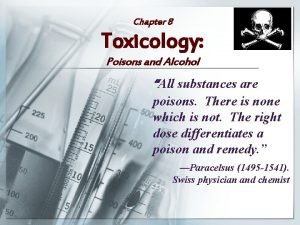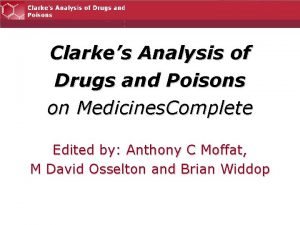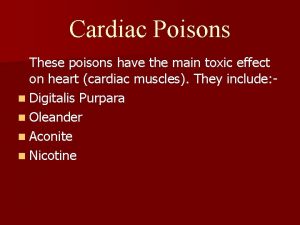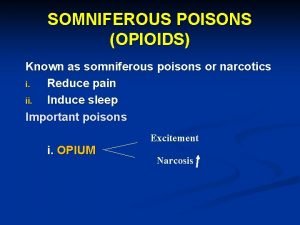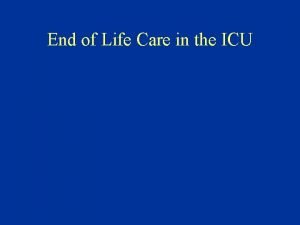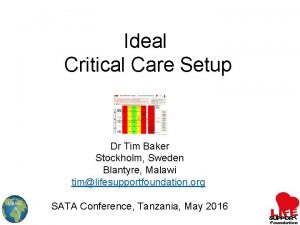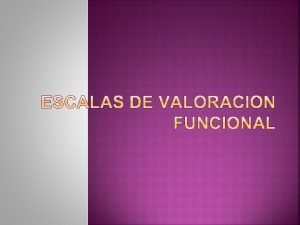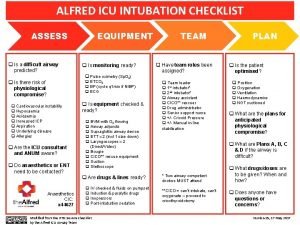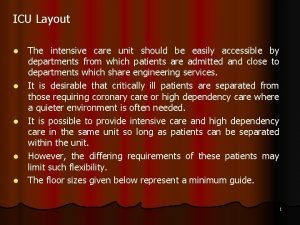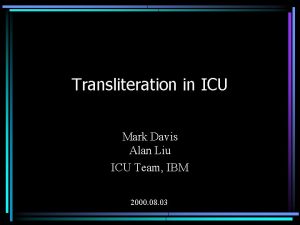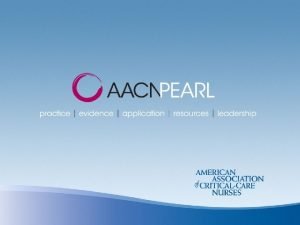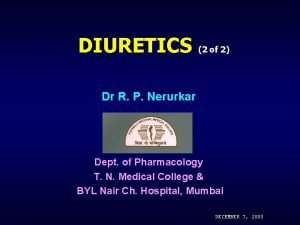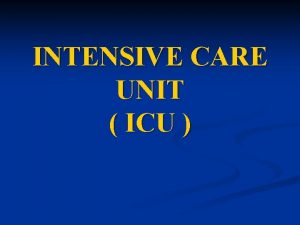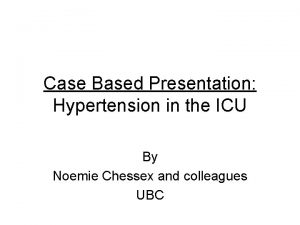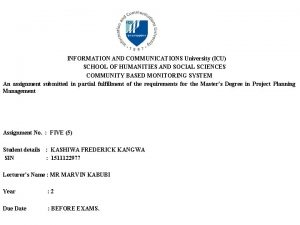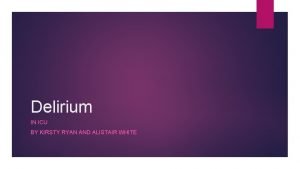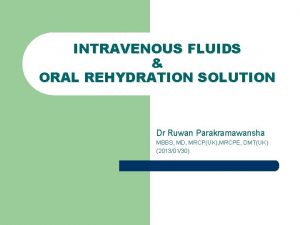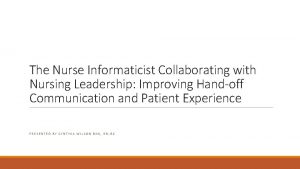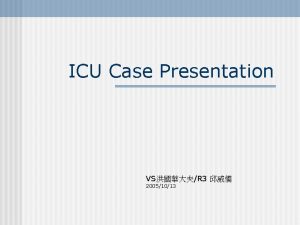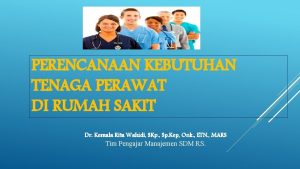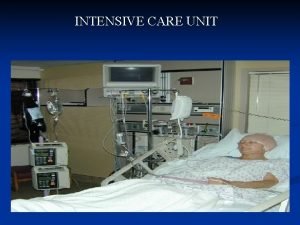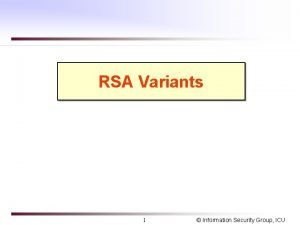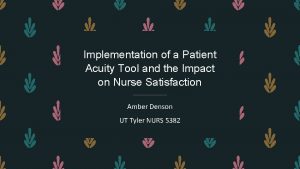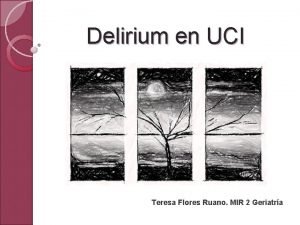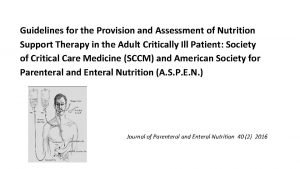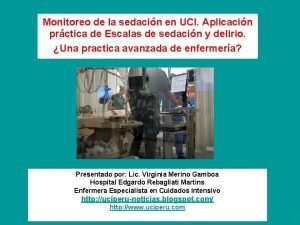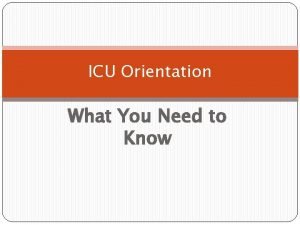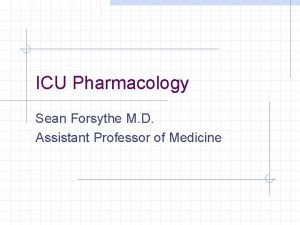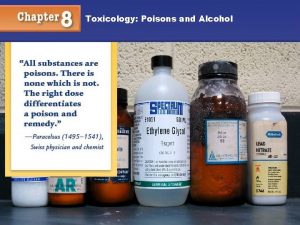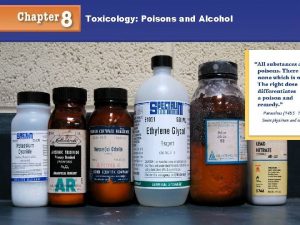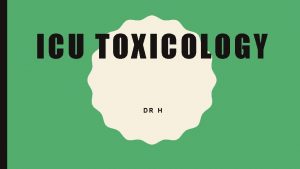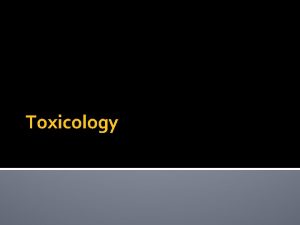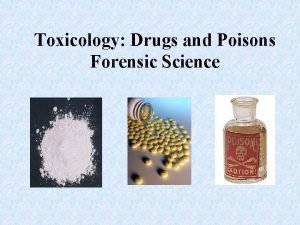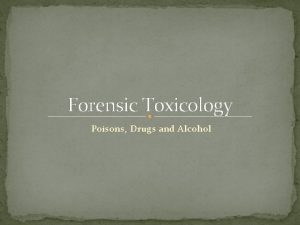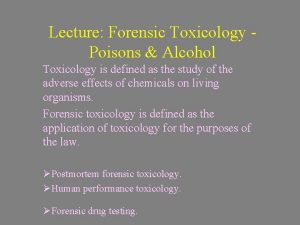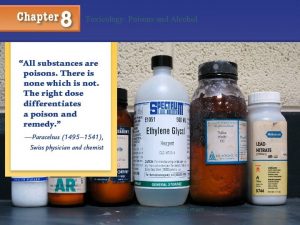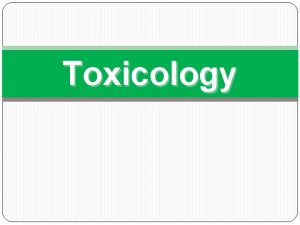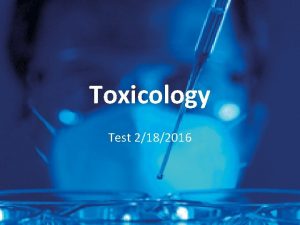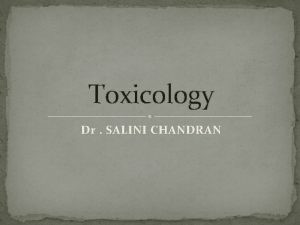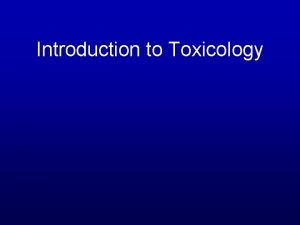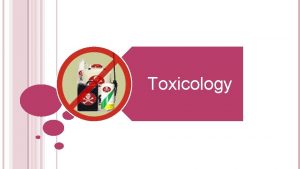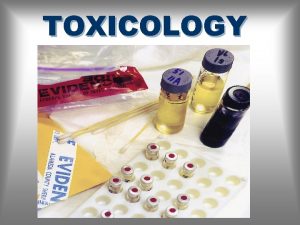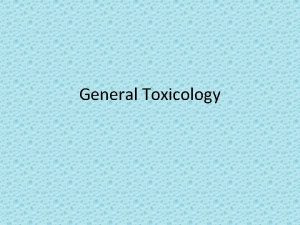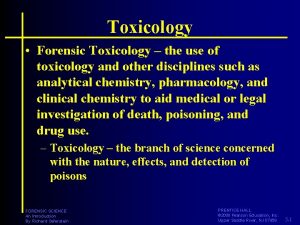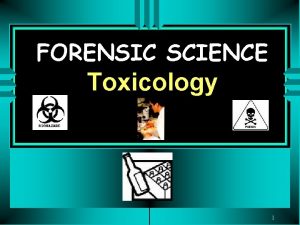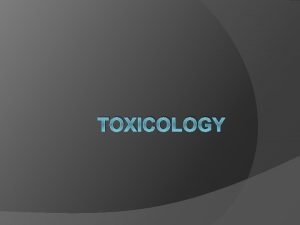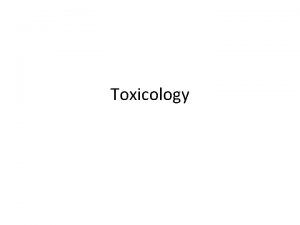ICU TOXICOLOGY DR H ALL THINGS ARE POISONS








































- Slides: 40

ICU TOXICOLOGY DR H

“ALL THINGS ARE POISONS, FOR THERE IS NOTHING WITHOUT POISONOUS QUALITIES. IT IS ONLY THE DOSE WHICH MAKES A THING POISON. ” ― PARACELSUS

LD 50

THEOBROMINE TOXICITY 1000 MG/KG IN HUMANS 200 MG/KG IN CATS 300 MG/KG IN DOGS

OBJECTIVES • Street Drugs • Toxidromes • Treatment for Poisoning

TENANTS TO ALL EMERGENCY CARE 1 -800 -222 -1222 • Secure the airway • Place the patient on a monitor! • Have IV access (lots of it) • Provide supportive care – Serial EKGs and labs –Benzodiazepines are your toxicology friend

GENERAL CONSIDERATIONS IN OVERDOSE AND ALTERED MENTAL STATUS • Dextrose (1 amp) • Thiamine (100 mg) • Naloxone (0. 2 -0. 4 mg – escalate to 2 to 10 mg if necessary) – Ideally you don’t want to precipitate withdrawal but personally I don’t care if a patient has stomach cramps if I save their life – Consider a gtt – Monitor for seizures if OD is with tramadol or meperidine – Little known fact, naloxone is good for Clonidine OD!


GI DECONTAMINATION • I rarely do it. • If you do it, contraindications include compromised airway, ileus, and bowel obstruction • Activated Charcoal – 0. 5 -1 g/kg in children or 25 to 100 g in adults – Ingestion was <1 hour ago and the drug is known • Salicylate • Whole Bowel Irrigation – large volumes (1. 5 -2 L/h) of a polyethylene glycol-based solution to facilitate rapid transit of a toxin through the GI tract. In volunteer – consider following ingestion highly toxic, extended-release preparations • verapamil, iron, asymptomatic drug packers

TO UDS OR TO NOT UDS • Actual and Factual – benzodiazepine testing is for oxazepam Drug Detection Period Amphetamine 4 d Barbituate 24 h (sa) 3 wk (la) Benzodiazepine 3 d (sa) 4 wk (la) Cocaine 3 d Marijuana 3 d (su) 4 wk (lu) Opiates 4 d Phencyclidine 8 d – cannabinoid testing is for d -9 tetrahydrocannabinol • False Negatives – Lorazepam and Alprazolam have different metabolites – Synthetic Opiates (fentanyl, Demerol, methadone, propoxyphene) – Synthetic Cannabinoid (JWH-018 aka Spice) • False Positives – Amphetamines (pseudoephedrine) – Benzodiazepines (some NSAIDs) – Opiate (quinolones) – PCP (diphenhydramine) – TCA (diphenhydramine, cyclobenzaprine, carbamazepine, quetiapine)

LEVELABLE DRUGS • • • Digoxin Salicylate Acetaminophen Theophylline Alcohols – Ethylene Glycol, Et. OH, Methanol • Metals – Iron, Lead, Mercury • AEDs – – Valproate Carbamazepine Phenytoin Lithium • Heme (arterial oxygen saturation gap PO 2 -Coox >5%) – Carbon Monoxide, Carboxyhemoglobin, Methemoglobin, Sulfhemoglobin

DIALYZABLE DRUGS • Salicylates • Phenobarbital • Theophylline • Methanol • Ethylene glycol • Lithium • Diethylene glycol • Propylene glycol • Isopropyl alcohol • Valproic acid • Carbamazepine

ANION GAP TOXICOLOGY IS ITS ONLY TRUE APPLICATION • +AG – “unmeasured anions” tells you to order an Osm Gap • Toxic Alcohols • -AG – Lithium, Bromide, Iodide

OPIATES • Smack, Horse, Mud, Brown Sugar, Junk, Black Tat, Big H, Paregoric, Dover’s Powder, MPTP (New Heroin), Hilbilly Heroin, Lean or Purple Drank, OC, Oxy, Oxycotton, Sippin Syrup • Tablets, capsules, skin patches, powder, chunks in varying colors (from white to shades of brown and black), liquid form for oral use and injection, syrups, suppositories, and lollipops – swallowed, smoked, sniffed, or injected • Poppy papaver somniferum is the source for all natural opioids • Highly addictive • “Narcotic” = “Stupor” – dulls the senses and relieves pain

OPIATE TOXIDROME MO RPHI NE, HYDROC ODONE , CO DE INE , HY DRO MO RPHONE, FENTANYL, PROPOXYPHENE, TRAMA DOL, M ETHA DON E • Lethargy • Hypothermia • Respiratory Depression • Bradycardia and Hypotension • Miosis • Decreased Bowel Sounds – Miosis and a respiratory rate of 12 breaths/min are both sensitive (88% and 80%, respectively) and specific (90% and 95%, respectively) for predicting a response to naloxone.

OPIATE TOXIDROME • Altered mental status with depressed respiratory function • Seizures: meperidine, propoxyphene, and tramadol • QRS Prolongation: propoxyphene – sodium channel blockade • QT Prolongation: methadone – potassium efflux blockade • Chest Wall Rigidity: fentanyl (rapid infusion) • Protect the airway • Naloxone: 0. 2 -0. 4 mg – escalate to 2 to 10 mg if necessary – Half-life ~2 hours – Consider gtt • Consider sodium bicarb and benzo’s depending on presentation (seizures, abnl intervals on EKG, etc)

OPIATE WITHDRAWAL • Restlessness • Clonidine (anxiety) • Mydriasis • Ibuprofen (myalgias) • Lacrimation • Dicyclomine (abd cramps) • Yawning • Ondansetron (emesis) • Insomnia • Consider methadone • N/V/D • Muscle Cramps (including smooth muscle of intestine)

DEPRESSANTS • Barbs, Benzos, Downers, Georgia Home Boy, GHB, Grievous Bodily Harm, Liquid X, Nerve Pills, Phennies, R 2, Reds, Roofies, Rophies, Tranks, and Yellows • Pills, syrups, and injectable liquids • Euphoria • Misused to facilitate sexual assault

SEDATIVE HYPNOTIC SYNDROME BARBITUATES, BENZODIAZEPINES, GHB, ETOH • Lethargy – via binding at postsynaptic g aminobutyric acid type A channels , thereby promoting chloride influx and neuronal hyperpolarization • Respiratory Depression • Hypothermia • CNS depression is enhanced • Protect the airway

SEDATIVE HYPNOTIC SYNDROME • Baclofen – Hypothermia, hypotension, bradycardia, coma, seizures • Ƴ-Hydroxybutyrate – CNS depression and respiratory failure • Carisoprodol – Coma and myocolonus • Protect the airway • Benzodiazepines for seizures

SEDATIVE HYPNOTIC WITHDRAWAL • Tremors • Benzodiazepines • Hallucinations • Can consider beer • Agitation • Supplement (decrease amt of benzo’s) • Confusion – Dexmedetomidine • Autonomic overactivity – Gabapentin • Seizures

METHAMPHETAMINE • Batu, Bikers Coffee, Black Beauties, Chalk, Chicken Feed, Crank, Crystal, Glass, Go-Fast, Hiropon, Ice, Methlies Quick, Poor Man’s Cocaine, Shabu, Shards, Speed, Stove Top, Tina, Trash, Tweak, Uppers, Ventana, Vidrio, Yaba, and Yellow Bam • Pills, powder, rocks, and injectable liquids – swallowed, smoked, sniffed, or injected • Highly addictive • Stimulant (CNS) • Acute – “rush” (thought to be from dopamine) • Chronic – Violence, anxiety, confusion, insomnia, psychosis

SYMPATHOMIMETIC TOXIDROME COCAINE, AMPHETAMINES, PCP, CAFFEINE, PSEUDOEPHEDRINE, METHYLPHENIDATE • Mydriasis • Diaphoresis • Hyperthermia – Agitation & muscular hyperactivity • • • Tachycardia HTN Tachypnea Hypervigilence Psychosis Seizures • Cocaine toxicity responds well to benzodiazepines – Amphetamines are hit or miss

HALLUCINOGENS • Acid, Blotter Acid, Cubes, Doses, Fry, Mind Candy, Mushrooms, Special K, STP, X, and XTC – Ecstasy is sold in colorful pill form – LSD is sold in the form of impregnated paper (blotter acid), typically imprinted with colorful graphic designs. – Synthetic THC is also called K 2 or Spice • Deaths exclusively from acute overdose of LSD, magic mushrooms, and mescaline are extremely rare. Deaths generally occur due to suicide, accidents, and dangerous behavior, or due to the person inadvertently eating poisonous plant material. Synthetic THC however has been associated with MI and Renal Failure • Perceptual Distortions – Time and Space – Colors seem to change and take on new significance – Weeks or even months after some hallucinogens have been taken, the user may experience flashbacks — fragmentary recurrences of certain aspects of the drug experience in the absence of actually taking the drug.

HALLUCINOGENS • MDMA can also act as a sympathomimetic • IVF • In high doses, it interferes with the body’s ability to regulate temperature. • Cooling device – Hyperthermia can result in liver, kidney, and cardiovascular failure (i. e. death) • Benzodiazepines

INHALANTS • Gluey, Huff, Rush, and Whippets • Chemical Vapors From: – glue, lighter fluid, cleaning fluids, and paint • Rapid absorption through the lungs to the brain • Euphoria and feeling “high” • Routine use will cause brain damage • Death can occur from asphyxiation

DESIGNER CATHINONES AKA BATH SALTS • Bliss, Blue Silk, Cloud Nine, Drone, Energy-1, Ivory Wave, Lunar Wave, Meow, Ocean Burst, Pure Ivory, Purple Wave, Red Dove, Snow Leopard, Stardust, Vanilla Sky, White Dove, White Knight, White Lightening • Usually sniffed or snorted. Can also be ingested, smoked, or injected • Euphoria and Alertness (similar to cocaine and MDMA) • Adverse Effects: – Tachycardia, HTN, Hyperthermia, Mydriasis, Rhabomyolysis, Paranoia, Hallucinations/Delusions • IVF • Benzodiazepines

ANTICHOLINERGIC (ANTIMUSCARINIC) TOXIDROME ANTIHISTAMINES, TCAS, ANTIPYSCHOTICS, ANTIPARKINSONIAN, ANTISPASMODITCS/MUSCLE RELAXANTS, BELLADONNA ALKALOIDS/JIMSONWEED, OPHTHO MYDRIATICS, AMANITA MUSHROOMS • Blind as a bat (mydriasis with loss of accommodation) • PHYSOSTIGMINE – 0. 5 -2 mg IM/IV as needed • Mad as a hatter (delirium) • Repeat q 10 -30 min • Red as a beet (flushed) • HAVE ATROPINE AVAILABLE! • Hot as hell (hyperthermia) • Dry as a bone (anhydrosis) • Loss of tone (constipation and urinary retention) • Heart runs alone (tachycardia)

CHOLINERGIC TOXIDROME ORGANOPHOSPHATES, CARBAMATES, PHSYO/PYRIDOSTIGMINE, NERVE GAS, MUSCARINE MUSHROOMS • Inhibit neuronal acetylcholinesterase (ACh. E), resulting in acetylcholine accumulation and overstimulation of muscarinic and nicotinic receptors – – – – Miosis Salivation Lacrimation Diaphoresis Bronchorrhea (with bronchospasm) Urination N/V/D Bradycardia • ATROPINE – 2 -4 mg IM x 1 mild/moderate symptoms – 6 mg IM x 1 severe symptoms • Go half dose if elderly • PRALIDOXIME (2 -PAM) – 1 -2 GM IV x 1, then 250 mg IV q 5 min until symptoms reverse • Give 1 dose atropine first • Of note, respiratory muscle paralysis does not respond to atropine – Nicotinic hyperstimulation

SEROTONIN SYNDROME VS NEUROLEPTIC MALIGNANT SYNDROME SS: SSRIs, SNRIs, Bupropion, TCA, MAOIs, Anti-migraine, Lithium, Cyclobenzaprine, Fentanyl, Tramadol, Dextromethorphan, St. John’s Wart, Ginseng, Nutmeg, Antinausea, Linezolid, Ritonavir NMS: Dopaminergic withdrawal, Haloperidol, Fluphena/Thiorida-zine, Chlorpromazine, Cloza/Olanza/Quetia -pine, Risperi/Ziprasi -done, Metoclopramide, Promethazine, Aripiprazole, Droperidol, Procholeperazine

SS VS NMS SS NMS (RESTORE DOPAMINE) • MILD TO MODERATE – Benzo’s • MODERATE – Cyproheptadine (5 -HT 2 A antagonist) • SEVERE – Intubate and Sedate (benzo gtt) – Consider paralysis – Antihypertensive gtt? – Cooling device – I also give cyproheptadine – Bromocryptine 2. 5 -5 mg q 8 h (max 30 mg/day) – Amantadine 100 mg q 8 h (200 -400 mg/day) – Consider benzo’s • MODERATE TO SEVERE – Dantrolene 1 -2. 5 mg/kg IV (1 mg/kg q 6 h) – Consider ECT if neuroleptic cannot be restarted

ACETAMINOPHEN • The earlier the NAC, the better (treat until you can trend the acetaminophen level) – 140 mg/kg loading dose po followed by 70 mg/kg q 4 h x 17 doses po (tastes gross!) – 150 mg/kg over 15 -60 min followed by 12. 5 mg/kg/hr x 4 hours followed by 6. 25 mg/kg/hr x 16 hours – Consider longer treatment if levels are still high (or LFTs are still abnl) • Stages – Preclinical – Hepatic Injury – Hepatic Failure – Recovery • 5% of the dose is metabolized by CYPP 450 2 E 1 to N-acetyl-benzoquinone imine (NAPQI) • NAPQI is toxic (covalent binding to proteins and nucleic acids) • Glutathione detoxifies NAPQI (to cysteine and mercapturic acid conjugates) • N-acetylcysteine is synthesized to cysteine to improve glutathione stores • Transplant: – Arterial p. H < 7. 3 despite resuscitation – Or the combination of grade III/IV hepatic encephalopathy, prothrombin time >100 s, and serum creatinine level > 3. 4 mg/d. L.

SALICYLATES • Mechanism – uncoupling of oxidative phosphorylation, • decreased adenosine triphosphate (ATP) production, increased acidosis, and hyperthermia • Symptoms – Mild: tinnitus, hyperventilation, abdominal pain, vomiting (if intubated keep that respiratory drive!) – Severe: diaphoresis, delirium • URINARY ALKALINIZATION – 44 -100 m. Eq in 1 L of 5% dextrose in 0. 25% NS – 88 -150 m. Eq in 1 L of 5% dextrose at 2 -3 m. L/kg/h (adults 150 -200 m. L/h) – Goal urine p. H 7 -8. 5 / (keep blood p. H <7. 55) (monitor hourly) – Hypokalemia & Hypovolemia prevent effective alkalinization – Add 20 -40 m. Eq of K to each liter (unless there is renal failure) – Urinary excretion is more dependent upon urine p. H than renal flow rate – “trapping” salicylates in urine and serum (increasing excretion and decreasing further redistribution, esp to the brain) • HEMODIALYSIS – AMS, Pulmonary edema, Seizures, Elevated and rising levels (100 mg/d. L)

CARDIAC GLYCOSIDES DIGOXIN • Inhibit the sodium-potassium ATPase pump – ↑ intracellular sodium&calcium and extracellular potassium • Increased contractility – Increased automaticity with bradycardia and conduction blocks • DIGOXIN-SPECIFIC FAB FRAGMENTS – hyperkalemia (>5. 5 m. Eq/L) and life-threatening dysrhythmias – #vials = dig level (ng/m. L) x wt (kg) / 100 (give 6 if unsure) – #vials = 10 every 25 tabs/caps ingested acutely

INTRALIPID THERAPY • In the event of local anesthetic-induced cardiac arrest that is unresponsive to standard therapy, in addition to standard cardio-pulmonary resuscitation, Intralipid 20% should be given i. v. in the following dose regime: • Developed for LAST • Case reports in almost everything – Olanzapine – Lamotrigine – Bupropion – Dosulepin – Verapamil – Haloperidol – Quetiapine – Sertraline • Intralipid 20% 1. 5 m. L/kg over 1 minute – Take a 500 ml bag of Intralipid 20%and a 50 ml syringe. – Drawup 50 ml and give stat i. v. X 2 – Then attach the Intralipid bag to an iv administration set (macrodrip) and run it i. v. over the next 15 minutes – Repeat the initial bolus up to twice more – if spontaneous circulation has not returned. • Follow immediately with an infusion at a rate of 0. 25 m. L/kg/min • Continue chest compressions • Repeat bolus every 3 -5 minutes up to 3 m. L/kg total dose until circulation is restored • Continue infusion until hemodynamic stability is restored. Increase the rate to 0. 5 m. L/kg/min if BP declines • A maximum total dose of 8 m. L/kg is recommended (560 m. L for a 70 kg man)

CALCIUM CHANNEL BLOCKER & BETA BLOCKER OVERDOSE GLUCAGON HIGH-DOSE INSULIN THERAPY • IVF • Baseline glucose (goal ~200 mg/d. L) • 1 U/kg bolus • 0. 5 -1. 0 U/kg/h continuous infusion • 50 to 150 mcg/kg bolus (3 -10 mg for a 70 kg person) – Repeat q 3 -5 minutes • Continuous infusion – Initiate if more than two boluses given – Dose by effective bolus dose each hour (for example, if two 5 mg boluses given, rate should be 10 mg/hr) – • Dextrose infusion – • Increase by 2 U/kg/h every 10 min to a max of 10 U/kg/h 10% in ½ NS or 5 -10%D 5 W, goal glucose >100 Monitor – Glucose q 10 min & Potassium q 60 min while titrating insulin – Glucose q 30 -60 min & Potassium q 6 h when infusion rate stable

TOXIC ALCOHOLS (ETHYLENE GLYCOL &METHANOL) Ethylene glycol • Ophthalmoplegia • Cranial nerve palsies • Hyporeflexia • Myoclonus • ATN • Abnl (low) Ca, Mg, K Methanol • Headache • Confusion • Vertigo • Visual impairment & photophobia • afferent pupillary defect is an ominous sign • Blindness • Pancreatitis • Prevent renal failure (EG), permanent neurological damage, seizures, severe acidosis (and of course death) • FOMEPIZOLE Ethylene Glycol & Methanol dosing: 15 mg/kg IV q 12 h until level <20 mg/d. L; then 10 mg/kg IV q 12 h x 4; • Consider HD • Consider 1 -2 amps of Bicarb if p. H <7. 3 • Administer cofactors: thiamine, folate, pyridoxine • Ethanol can be substituted for fomepizole if it is unavailable

CARBON MONOXIDE • Rapidly absorbed odorless gas • 210 x the affinity for Hgb than O 2 • Shifts Oxygen-Dissociation curve to the left – Headache, Dizziness, Nausea → • Confusion → • Coma → – Death • MI can occur • Diagnose with multiwavelength co-oximetry – BUT TREAT BY SYMPTOMS • 100% OXYGEN • HBO is controversial

CYANIDE • Inhibits cytochrome a 3 in mitochondrial cytochrome oxidase, – No electron transport, No oxygen consumption, No ATP! • Rapid onset of: – coma, seizure, metabolic acidosis, tachycardia, and hypotension • SODIUM NITRITE & SODIUM THIOSULFATE – 300 mg IVx 1 of Nitrite followed by 12. 5 GM IVx 1 of Thiosulfate – Increases Met. Hgb to remove HCN from tissues – Thiosulfate turns HCN to thiocyanate which is renally excreted • HYDROXOCOBALAMIN – 5 GM IV – May repeat (doses of up to 20 GM have been used) – Turns HCN to cyanocobalamin which is renally excreted

HAVE A GOOD WEEKEND REMEMBER NO MORE THAN 12 SHOTS OF 40 PROOF ALCOHOL
 Chapter 8 toxicology poisons and alcohol
Chapter 8 toxicology poisons and alcohol Chapter 8 toxicology poisons and alcohol
Chapter 8 toxicology poisons and alcohol Insidan region jh
Insidan region jh 7 things all living things do
7 things all living things do Clarke's analysis of drugs and poisons
Clarke's analysis of drugs and poisons Cardiac poisons
Cardiac poisons Somniferous
Somniferous Erythism
Erythism Name all the lines
Name all the lines End of life care in icu
End of life care in icu Icu localization
Icu localization Alaeg
Alaeg Icu for dummies
Icu for dummies Escala del estado de conciencia
Escala del estado de conciencia Alfred icu
Alfred icu Amiodarone drip rate chart
Amiodarone drip rate chart Icu layout and design
Icu layout and design Icu transliterator
Icu transliterator Cam icu
Cam icu Lasix to bumex conversion
Lasix to bumex conversion Icu primer sekunder tersier
Icu primer sekunder tersier Icu case presentation
Icu case presentation List of lecturers at icu zambia
List of lecturers at icu zambia Cam icu
Cam icu Classification of iv fluids
Classification of iv fluids Icu medical b3108
Icu medical b3108 Icu case presentation
Icu case presentation Cara menghitung kebutuhan tenaga perawat rawat jalan
Cara menghitung kebutuhan tenaga perawat rawat jalan Intensive care unit definition
Intensive care unit definition Icu unicode
Icu unicode Emphancy
Emphancy Shanks algorithm example
Shanks algorithm example Patient acuity tool
Patient acuity tool Cam icu escala
Cam icu escala Diet chart for icu patients
Diet chart for icu patients Sedacin
Sedacin Kp icu jpm
Kp icu jpm Icu case presentation
Icu case presentation Icu orientation
Icu orientation Sean forsythe
Sean forsythe Icu security group
Icu security group

